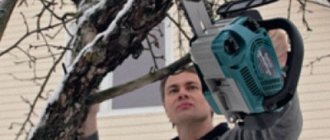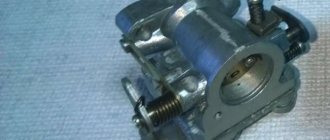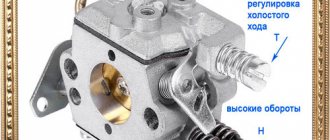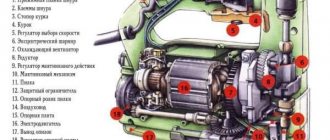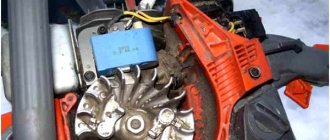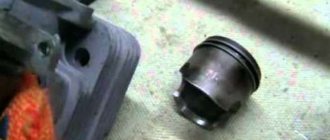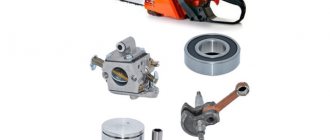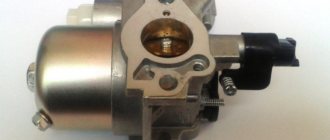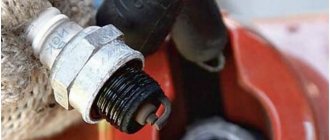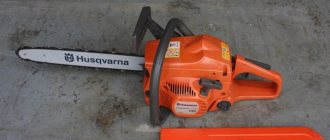Among the huge selection of models on the modern construction market, the Partner 350 chainsaw, which is produced by a subsidiary of Husqvarna, stands out.
General view of the Partner 350 chainsaw
Simple and easy to use, reliable and unpretentious, this saw has gained wide popularity among summer residents and owners of country houses. Sawing firewood, trimming trees and branches - this is not the entire list of jobs that this model can handle without problems. Despite the well-thought-out design and layout of the units, over time the power unit, transmission elements and fuel system wear out.
Chainsaw troubleshooting
Experienced fellers know that competent and accurate determination of the nature of the breakdown is half the repair work done. Based on many years of experience in repairing Partner 350 chainsaws, specialists have developed a special method for diagnosing problems.
Major breakdowns of the Partner 350 chainsaw
It is worth starting from the simplest components and mechanisms, ending with more complex ones.
This allows you to significantly save time and avoid unnecessary operations. Troubleshooting is recommended in the following order:
- Checking the chainsaw spark;
- Ignition coil;
- Diagnostics of the fuel supply system;
- Inspection of crankshaft bearings.
Checking the spark at the spark plug electrodes
To diagnose the presence of a spark, it is necessary to remove the spark plug and, without removing the high-voltage cable, make several jerks with the starter. If there is a discharge, you will need to set a gap between the central and side electrodes. Its value in Partner 350 should not extend beyond 0.7 to 1.2 mm.
Adjusting the spark plug gap with a feeler gauge
A lack of this distance can lead to incomplete combustion of the fuel mixture and, as a result, increased fuel consumption with limited power of the unit. As a result of exceeding these parameters, inconsistency in the occurrence of a spark and interruptions in the operation of the internal combustion engine are observed.
If there is no spark at the electrodes, it is necessary to replace the spark plug and repeat the diagnostic procedure described above.
If a discharge is also not observed on the replacement spark plug, it is necessary to check the integrity of the high-voltage wire and, if necessary, replace it.
Diagnostics and ignition adjustment Partner 350
The absence of a bright blue spark in the spark plug may indicate the need to inspect the ignition module and adjust the gap. For these purposes, remove the plastic protective casing from the saw and check the condition of the coil. The wires leading to it must be firmly fixed with screws and must not dangle at the connection point. There should be no moisture on the flywheel of the drive shaft, as it interferes with the generation of the electromagnetic field.
Flywheel and ignition module of Partner 350 chainsaw
If there are no such discrepancies, you must ensure that the gap between the module and the flywheel is set correctly. Its value should be no more and no less than 0.2 mm, and therefore if it does not coincide with the recommended distance, you will need to independently adjust the ignition of the Partner 350 chainsaw.
For the most accurate adjustment, you will need a regular coin-shaped or flat probe, which can be purchased in specialized or automotive stores.
After checking the ignition, we move on to diagnosing the fuel supply system.
Chainsaw fuel system 350
An important influence on the correct operation of the saw is played by the fuel system, consisting of a gas tank, pipes and a carburetor.
Carburetor Partner 350 disassembled
If the mixture does not flow from the tank, you need to inspect the built-in filter and breather (hole in the lid). If the fuel filter is clogged, it will need to be replaced. To clean the breather, you can use a regular sharp needle, carefully removing any remaining dirt and sawdust from the valve. If the carburetor becomes clogged, it will need to be dismantled and thoroughly cleaned.
It must be remembered that the partner chainsaw carburetor is a complex assembly consisting of many small parts. Therefore, maximum care must be taken during dismantling, cleaning and assembly.
The principle of operation of the carburetor
The carburetor is used to mix the fuel mixture (oil and gasoline) with air. Its work begins from the moment the saw starter jerks, which forces the membrane to pump fuel. A diaphragm-controlled needle valve then supplies gasoline to the main chamber, through which it enters the cylinder. By means of the throttle valve, you can “enrich” or “lean” the fuel mixture with air. When it closes, less air will enter the cylinder at the same fuel level. In this case, consumption will increase coupled with a drop in engine power. Therefore, adjusting the Partner 350 chainsaw plays an important role in creating the optimal balance between moderate fuel consumption and high tool performance.
It is recommended to do the setup yourself only if you have special tools and skills.
Troubleshooting common problems
The Partner 350 has popular faults that owners of these saws can diagnose and fix themselves. Let's take a closer look at popular faults and how to repair them yourself.
Stalls when you press the gas
If the Partner 350 stalls when you press the gas, then most likely there is a problem with the fuel system. The most common breakdown is an incorrectly adjusted carburetor or its malfunction, as well as extraneous air leaks.
Tip: If the chainsaw stalls when the speed increases, you should not immediately adjust the carburetor. Start by checking the engine for foreign air leaks. One of the signs of air leaks is increased idle speed.
Starts and stalls
If the Partner 350 starts up and immediately stalls, then, as in the previous case, there may be several reasons, but the most common is a difficult fuel supply. You should start troubleshooting by checking the condition of the fuel filter and lines. If the fuel flows normally, then check the spark and try to start the chainsaw on a new spark plug, as the saw may stall due to interruptions in sparking.
It is also necessary to check the draft of the air damper. If it does not open the air damper or does not open it completely, the engine may stall due to excessive fuel enrichment.
Lack of chain lubrication
There are several reasons for the lack of lubrication supply on the Partner 350 chainsaw, and in this case we can list them all.
- Oil line rupture.
- Oil filter clogged.
- Defective worm drive gears.
- Line or pump clogged.
Do-it-yourself Partner 350 carburetor setup
Before starting adjustment work, it is necessary to clean the main fuel unit from dust and dirt. To do this, you can use a compressed air compressor or a carpentry brush.
To adjust the carburetor, there are holes on the left side of the power unit, but to make it easier to determine their position, experts recommend removing the protective plastic casing. First, tighten the fuel quantity and quality screws all the way clockwise, then loosening them by 1/5 ... ¼ turn.
Partner 350 chainsaw carburetor with adjustment screws
With the cover removed, you need to know that the fuel mixture quality screw is located on the right and, accordingly, the gasoline quantity adjustment screw is located on the left. For convenience, the carburetor body is marked under the bolts:
— “L” — fuel quantity screw (adjustment at low speed);
— “H” — mixture quantity screw (setting at maximum speed);
— “T” — idle speed adjustment bolt.
It is necessary to remember that the carburetor adjustment of the Partner 350 chainsaw must be done on a warm engine. At high temperatures, the metal expands linearly, as a result of which the throughput of the channels increases.
As soon as the cylinder becomes warm, tighten screw “L” until the internal combustion engine produces maximum crankshaft speed. Then tighten it a quarter turn. It is worth noting that in this position the mixture supply quantity screw should maintain the engine running at idle speed. If this setting is not enough, then feel free to unscrew the “T” bolt until the engine runs stable. Using screw “H” we adjust the operation of the Partner chainsaw at maximum speed.
Diagnostics of crankshaft bearings
An important factor in the correct operation of the engine is the bearings and seals of the crankshaft.
Crankshaft Partner 350 with bearings
To diagnose their wear, it is necessary to shake the flywheel mounted on the shaft in the vertical and horizontal plane. If there is obvious play, the rolling bearings must be replaced. If there are oily marks on the crankcase, the seals will also need to be replaced. It would be a good idea to check the crankshaft play of the Partner 350, for which we remove the cylinder and piston. Using our hands, we shake it left and right, thereby imitating natural movement.
Oil pump repair and drive sprocket replacement
Repair of the oil pump on the Partner 350 chainsaw is necessary if the oil supply has completely or partially stopped. The oil pump mechanism includes the pump itself and a gear with a worm gear, which is driven by a sprocket connected to the clutch.
The most common problem with an oil pump is missing threads and splines on the gear or splines on the worm gear. The situation can be corrected by replacing the parts with new ones.
To remove the oil pump on the Partner 350, you need to remove the side cover and the chainsaw tire, then lock the piston and use a special wrench or a homemade wrench from the 24mm socket to unscrew the clutch.
The clutch has a high tension torque, so you need to use a wrench and turn it strictly clockwise. Do not try to unscrew the clutch with a hammer and chisel, this often leads to breakdown of the mechanism and also has a bad effect on the condition of the crankshaft bearings.
To replace the Partner 350 drive sprocket, you simply need to unscrew the clutch, remove the old part and install a new one. The sprocket is mounted on the shaft through a needle bearing. When replacing the sprocket, it must be checked for defects and lubricated. For lubrication, you can use regular Litol or any other that can withstand high speeds.
The process of replacing the drive sprocket is shown in the video, after watching which you can easily repeat what you saw on your chainsaw.
Typical malfunctions and breakdowns of the Partner 350 chainsaw
The vast majority of product malfunctions occur due to problems in the engine
and related systems. Typically, to repair the unit, it must be disassembled. To avoid making mistakes during the disassembly process, read more about the design of the chainsaw in the video or operating instructions.
Malfunctions with the ignition system
When your chainsaw won't start, you should first check to see if the spark plugs are working properly.
, giving a spark, due to which the fuel ignites and the force of the impulse pushes the piston, which does useful work.
In order to assess the condition of the spark plug, you need to remove the wire going to it from the starter and unscrew it from the groove using a suitable size key. Examine the candle: its appearance will tell you what happened to the chainsaw:
The consequence of such malfunctions is the inability of fuel to penetrate the cylinder and begin to carry out useful work by rotating the chain, so the chainsaw will not start
. The reasons for this are the following:
To determine whether the breather or filter is clogged with foreign objects, you will need to disconnect the fuel hose
and see if gasoline flows from it and with what pressure. If gasoline flows out slowly and weakly, then clean the breather with a thin, sharp object, such as an awl. If the problem is the filter, then remove it from the tank where the fuel is stored and clean it, and, if necessary, replace it.
Have you discovered that the cause of your problems lies in the carburetor? The good news here is that if the filter on your carburetor becomes clogged, you can easily clean it yourself. In addition, you can easily adjust and configure the carburetor of the Partner 350 chainsaw with your own hands if you strictly follow the recommendations from the operating instructions.
The bad news is that other, more complex carburetor repairs are unlikely to be done by yourself, and you will have to take your unit to a mechanic. Sometimes the manufacturer deliberately does not write in the instructions how to adjust and repair the carburetor
so that people who do not understand the structure of the product do not try to fix the malfunction on their own if the chainsaw suddenly stops starting, and as a result do not completely break the unit.
Troubleshooting cylinders and piston group
The main failures of this system
chainsaws include:
If you want to find out if there is a problem with the cylinders, the easiest way to do this is to remove the muffler and assess the situation
, looking through the hole left from the removed muffler at the insides of the cylinders. If repairs become necessary, you will, of course, need to remove the cylinder head to allow open access to the pistons and cylinders.
Muffler cleaning and repair
Sometimes, having accelerated your chainsaw to high engine speeds, you are surprised to discover that the motor cannot cope with them, and your tool stalls. At the same time, smoke begins to pour out of the muffler. However, the motor runs easily at low speeds.
In this case, there is a high probability that the muffler of your unit is clogged with carbon deposits.
and other products of incomplete combustion of fuel, so it must be cleaned. This work is done as follows: you will need to remove the muffler from the chainsaw and disassemble it; then clean its outer and inner surfaces from carbon deposits; in the last step, dry it with a hairdryer and install it on the chainsaw.
Please note that to avoid clogging the cylinders with debris, it is recommended to cover the muffler hole with a plug or a rag.
Replacement PISTON, Chainsaw Partner 350,351. Replacement of CPG, cylinder-piston group.
In this video we will disassemble and not assemble a CHAINSAW Partner
.
We will quickly replace the piston
on the Partner and clarify.
The connecting rod mechanism is quite complex and the chainsaw has a “ Partner”
350″. Its malfunctions are often accompanied by loud engine operation. It should also be noted that when the connecting rod mechanism breaks down, the carburetor often fails. In this case, it is more expedient to start repairing the Partner 350 chainsaw with your own hands by inspecting the ignition module. You will also need to fully check the coupling. In particular, the condition of the centrifugal clutch deserves attention.
In order to inspect it, you need to remove the top cover. The clutch itself in this model is located near the carburetor. To get to the centrifugal clutch in the saw, the flywheel is removed. Next, the carburetor head is disconnected. In this case
It is important not to damage the fuel system. The centrifugal clutch is bolted on. This part can be disconnected using a key. If cracks are visible under the cylinder, then the clutch will have to be replaced. However, some experts advise not to rush into this. If the cracks are shallow, you can try to grind the surface a little with a file.
